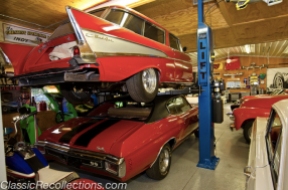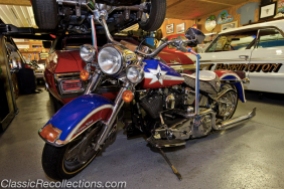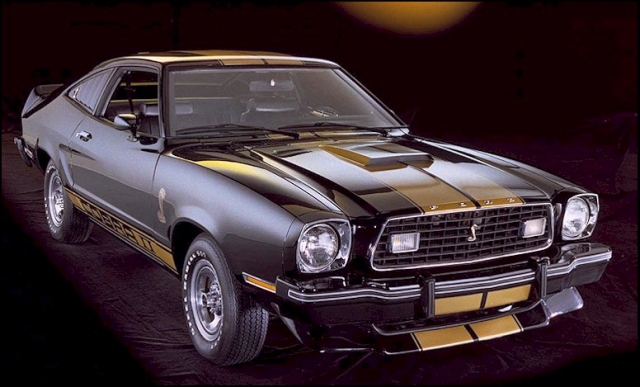Seriously!!!!!! Some Stable!!!
______________________________________________________________________________
Chuck has customs, trucks and of course, muscle cars in his collection.
Automotive enthusiasts love to measure their beloved four-wheeled machines’ capabilities by using the term “horsepower.” Chuck Barnes owns a stable-full of true classic muscle — real horsepower — in his modern horse barn.
A few years back, this Barrington resident built a free-standing barn to house not only his family’s show horses, but also his personal vehicles, each packing enough stallions under the hood to intimidate even the brawniest of V-8s.
While Barnes sees beauty in his collection, the “huge eyesore” of a horse barn initially caused some friction between he and his wife.
“She used to be able to have a wonderful view from our kitchen of the animals grazing in the pasture,” Barnes said.
Despite the earlier conflict, Dawn Barnes has grown accustomed to the structure and even enjoys it now. “It’s true he blocked my view, but I’m over it. It’s such a wonderful place to have parties in,” Dawn said. “In addition to hosting a wedding in the barn, I’ve even had my own ‘women’s parties’ where I just invited my female friends to hang out.”
To be fair, Chuck did try to avoid obscuring the tranquil vista; he first added to the home garage, expanding it from two cars to accommodate four.
“It just wasn’t quite enough,” Chuck said. That’s when he began construction on the satellite structure, drawing on personal experience for inspiration. “In the ’50s, my dad owned a speed shop called Belmont Automotive in Palatine. As a kid I used to go hang out there all the time and would see some really neat cars.”
That passion manifested itself in the cool space Chuck spends most of his time in now. “All the memorabilia is stuff I’ve accumulated over the years. Even with millions of dollars, you can’t recreate this. Nothing here is bought out of a catalog. They’re real pieces — even the moose head!”
In addition to car parts, hand-painted signs and neon lights, the custom centerpiece is a wood-paneled bar that a cabinetmaker friend assembled. “We told him we wanted something as cool as the cars, so he made the countertop one large glass shadow box, illuminated by LED lighting.” The couple constantly changes the display, ensuring guests will see something new.
The entire building has air conditioning to keep things comfortable during the summer months and a special warming element for the bone-chilling Midwest winters: radiant in-floor heat. ”You can walk in here in February with bare feet and be nice and toasty,’ Chuck said. “In addition to efficiency, it also keeps moisture down and doesn’t kick up dust or dirt.”
Naturally, visitors don’t come just to see the fascinating décor, but also the rolling iron parked inside. One such creation is a 430-horsepower 1970 Chevrolet Chevelle, packing a full emission-compliant LS E-Rod crate motor.
“It has full catalytic converters and passes the very strict California emissions test that will be mandated for all cars in 2014,” he said.
Other interesting pieces are a 1960 Buick Electra 225; a mint, 11,000-mile one-owner 1978 Ford F250 High Boy; and a project 1957 Chevrolet Nomad that came from Australia.
“I’m going to add an air-ride suspension and a fuel-injected big block. It’ll be a high-end car that can be driven anywhere.”
Another ongoing build is a 1964 Chevrolet Impala, being built as a tribute to Chuck’s father. “It’ll be a period-correct superstock race car that will be raced in nostalgic events,” he said.
While this equine palace is packed, Chuck is already planning for future expansions to his stable of steeds. So the next time you hear a classic collector talking about his impressive horsepower numbers, ask him if he’s got it both under his hood, and under his roof.
Automotive enthusiasts love to measure their beloved four-wheeled machines’ capabilities by using the term “horsepower.” Chuck Barnes owns a stable-full of true classic muscle — real horsepower — in his modern horse barn.
A few years back, this Barrington resident built a free-standing barn to house not only his family’s show horses, but also his personal vehicles, each packing enough stallions under the hood to intimidate even the brawniest of V-8s.
While Barnes sees beauty in his collection, the “huge eyesore” of a horse barn initially caused some friction between he and his wife.
“She used to be able to have a wonderful view from our kitchen of the animals grazing in the pasture,” Barnes said.
Despite the earlier conflict, Dawn Barnes has grown accustomed to the structure and even enjoys it now. “It’s true he blocked my view, but I’m over it. It’s such a wonderful place to have parties in,” Dawn said. “In addition to hosting a wedding in the barn, I’ve even had my own ‘women’s parties’ where I just invited my female friends to hang out.”
To be fair, Chuck did try to avoid obscuring the tranquil vista; he first added to the home garage, expanding it from two cars to accommodate four.
“It just wasn’t quite enough,” Chuck said. That’s when he began construction on the satellite structure, drawing on personal experience for inspiration. “In the ’50s, my dad owned a speed shop called Belmont Automotive in Palatine. As a kid I used to go hang out there all the time and would see some really neat cars.”
That passion manifested itself in the cool space Chuck spends most of his time in now. “All the memorabilia is stuff I’ve accumulated over the years. Even with millions of dollars, you can’t recreate this. Nothing here is bought out of a catalog. They’re real pieces — even the moose head!”
In addition to car parts, hand-painted signs and neon lights, the custom centerpiece is a wood-paneled bar that a cabinetmaker friend assembled. “We told him we wanted something as cool as the cars, so he made the countertop one large glass shadow box, illuminated by LED lighting.” The couple constantly changes the display, ensuring guests will see something new.
The entire building has air conditioning to keep things comfortable during the summer months and a special warming element for the bone-chilling Midwest winters: radiant in-floor heat. ”You can walk in here in February with bare feet and be nice and toasty,’ Chuck said. “In addition to efficiency, it also keeps moisture down and doesn’t kick up dust or dirt.”
Naturally, visitors don’t come just to see the fascinating décor, but also the rolling iron parked inside. One such creation is a 430-horsepower 1970 Chevrolet Chevelle, packing a full emission-compliant LS E-Rod crate motor.
“It has full catalytic converters and passes the very strict California emissions test that will be mandated for all cars in 2014,” he said.
Other interesting pieces are a 1960 Buick Electra 225; a mint, 11,000-mile one-owner 1978 Ford F250 High Boy; and a project 1957 Chevrolet Nomad that came from Australia.
“I’m going to add an air-ride suspension and a fuel-injected big block. It’ll be a high-end car that can be driven anywhere.”
Another ongoing build is a 1964 Chevrolet Impala, being built as a tribute to Chuck’s father. “It’ll be a period-correct superstock race car that will be raced in nostalgic events,” he said.
While this equine palace is packed, Chuck is already planning for future expansions to his stable of steeds. So the next time you hear a classic collector talking about his impressive horsepower numbers, ask him if he’s got it both under his hood, and under his roof.

































